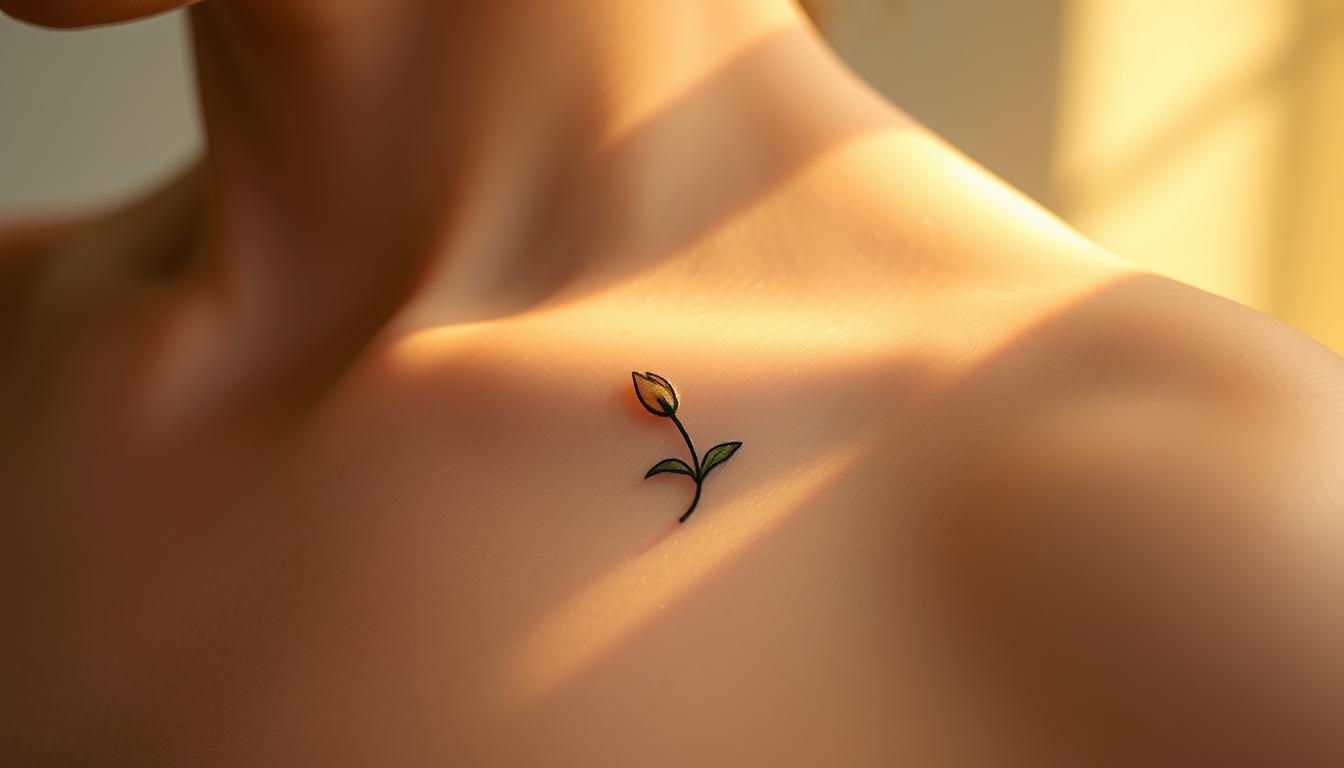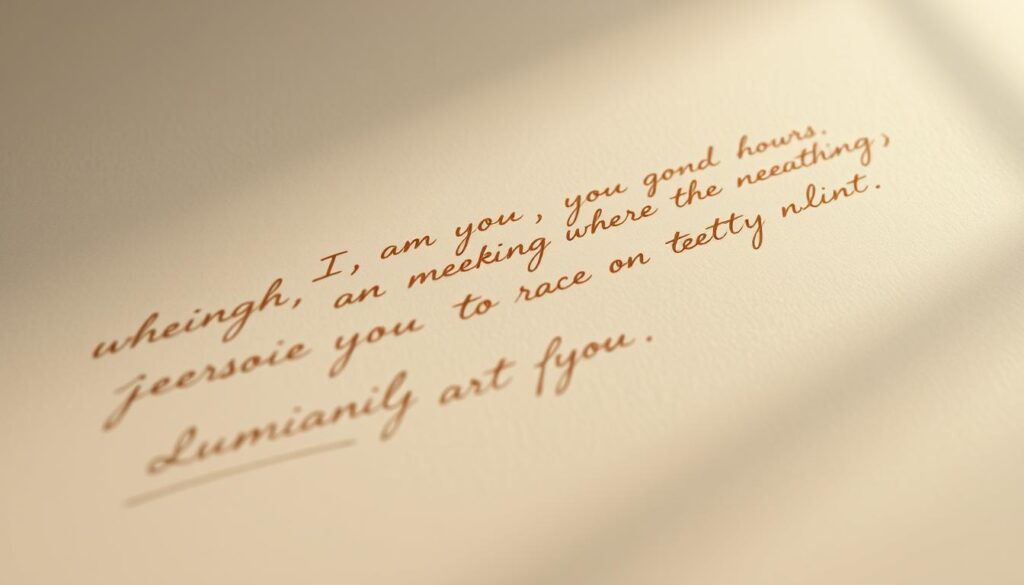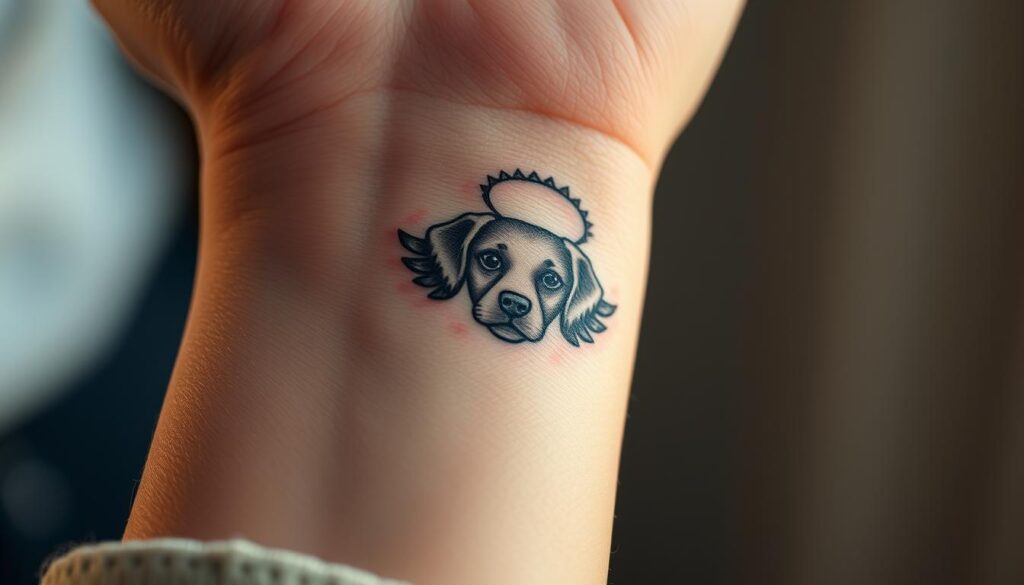
Can a tiny mark on your skin hold a lifetime of meaning? We ask that because many of us look for a gentle way to remember a loved one while keeping daily life simple.
We’ve seen survey data showing how common body art has become. About 42% of U.S. adults ages 18–69 have at least one tattoo, and regret is rare for pieces that honor a person or event.
This guide helps us choose compact, wearable tributes — from a small heart or Roman numeral to a delicate signature or paw print. We focus on clean lines and smart placement so the design remains crisp over time.
Throughout, we’ll point to motifs people favor and share practical tips for working with an artist to make a tiny emblem feel truly ours.
Key Takeaways
- Compact memorial designs let us remember a loved one without overwhelming daily life.
- Common motifs include hearts, Roman numerals, handwriting, wings, and paw prints.
- Few people regret a memorial tattoo over time; many find it healing.
- Placement and crisp line work matter for longevity at a small scale.
- Collaborate with an artist to make symbols feel uniquely yours.
Why small memorial tattoos help us honor loved ones
Many turn to compact skin symbols to keep a connection with someone they miss. We see this as a gentle way to hold memory without shouting it to the world.
Researchers and observers note a growing trend: remembrance marks can be a public expression of loss and a private comfort at once.
We find that a tiny piece often feels more wearable day to day. It offers a quiet anchor during hard moments without demanding attention. That balance helps people manage grief while they move through daily life.
Many describe the act as cathartic. A simple line, a date, or a tiny symbol can honor what mattered and ease the heavy ache of absence.
- Minimal designs can carry a lifetime of meaning.
- Matching tributes create shared rituals and strengthen bonds.
- Visibility choices let us decide when to show and when to keep private.
We encourage patience in design. Journal thoughts, collect reference images, and work slowly so the intent feels right.
There is no single right way — what matters is that the memorial tattoo feels true to you and helps keep close the people you love.
Passed away in memory tattoos small: tiny symbols with big meaning

A single micro icon can hold a full story we want to keep close. We walk through classic motifs that read well at a reduced scale and still carry deep intent.
A tiny heart or an infinity loop works as a direct, timeless symbol. A pared-back cross can mark faith without crowding the design. Pairing a heart with an initial or a cross with a Roman numeral gives layered meaning.
Butterfly, dragonfly, and dove for transformation and hope
The butterfly and dragonfly suggest change and renewal. A simple dove offers calm and peace. These symbols feel uplifting and suit micro linework or delicate micro-inks.
Hummingbird and cardinal as signs of presence
Hummingbirds hovering near a date or a cardinal perched by initials make a quiet statement of remembrance. We favor light linework and a dot of color to keep these icons readable over years.
- Why linework matters: Clean lines and negative space keep icons crisp.
- Placement tips: Wrist, ankle, and behind the ear work well for micro icons.
- Design touch: One subtle color dot can add warmth without losing simplicity.
Names, dates, and Roman numerals that say it all
Names and dates can act like small anchors, reminding us of who shaped our days. We favor clean scripts and tight layouts so the piece stays readable as years pass.
First name or “one name” scripts near the wrist
A single elegant name—one name—on the inner wrist or collarbone reads as both private and present.
We pick cursive or a simple serif depending on the person’s energy. Test the scale on paper and skin so the strokes don’t blur.
Birth and death dates in Roman numerals
Roman numerals give dates a timeless, refined look. They compress long numbers into tidy groups that suit micro work.
Choose classic serif numerals for formality or modern sans for a cleaner feel. Add tiny separators—dots or hearts—for clarity.
Intertwining dates with the infinity symbol
Woven dates and an infinity loop signal ongoing love without crowding the layout. The loop can cradle numerals or a loved one name.
We recommend leaving white space around the motif and pairing it with a minimal heartbeat or anchor to add subtle metaphor.
- Quick tips: Test on skin, favor bold single strokes, and keep breathing room around elements.
Handwriting tattoos: a personal way to remember loved ones

Handwritten lines can turn a brief note into a daily, wearable keepsake. A direct transcription of a card or short scrawl captures the unique pressure and rhythm of a person’s hand.
Short phrases like “until we meet again,” “love always,” or a nickname work best for legibility. We favor single words or a brief sentence to keep letters clear as years pass.
Bring a high-quality picture of the script and several samples so lettering specialists can match stroke weight and flow. Tattoo artists who focus on fine-line lettering preserve contrast and prevent loops from blurring.
- Prep a clean picture of the note and several scans.
- Choose placements where lines sit flat: inner forearm, collarbone, or rib.
- Proof the final stencil carefully before the session.
We suggest pairing the handwriting with a tiny symbol to anchor the piece, but avoid over-stylizing the original penmanship. A faithful script makes a quiet memorial tattoo that helps us carry a loved one through everyday life.
Micro portraits and outlines that keep faces in our memory
A micro portrait or simple outline lets us carry a photo’s essence on skin.
We compare hyper-real micro portrait work with minimalist outlines and weigh detail versus longevity. A highly detailed face can look stunning at first but may blur over time. Clear outlines or single-needle shading often keep a likeness longer and read better at tiny scale.
Choose a high-contrast picture and mark which feature of the person matters most—eyes, smile, or profile. That focus guides the design and helps the artist simplify without losing soul.
Placement matters. Upper arm, forearm, or calf stretch less and protect fine lines. Add a tiny frame, laurel, or date to finish the composition without crowding it.
Find an artist with a proven portrait portfolio. Expect careful stencil work, longer setup, and patient shading. Follow aftercare closely so the fine detail heals clean. If realism feels risky, a silhouette or outline keeps a memorial presence while favoring clarity.
Pet memorial tattoos to keep a best friend close

A little paw or nose mark can hold a whole story about a bond that brightened our years. We favor clean, true-to-print marks that feel personal without being ornate.
Tiny paw prints and nose prints
Real impressions make the most honest keepsakes. A tiny paw or nose taken from an inked stamp reads clearly and feels like a direct touch from the companion we miss.
Minimal pet portrait or paw-in-hand linework
A pared-back portrait often captures ears, whiskers, or a signature gaze with a few confident lines. The paw-in-hand outline is a tender symbol of companionship and trust.
Rainbow bridge and watercolor paw ideas
Soft watercolor washes and a pastel paw can add gentle color without heavy shading. The rainbow bridge motif gives sentimental shape to the idea of crossing to a peaceful place.
- Prep photos: High-contrast shots and clear prints help the artist scale the design.
- Placement: Ankle, inner wrist, or behind the ear keep the mark private yet present.
- Customization: Tuck a pet name initial or a tiny toy icon to reflect personality.
When we plan a tribute, we test size on paper and consult an artist experienced with micro work. For more cute inspiration that fits this approach, see our guide to small, wearable designs. This helps us choose a design that will help us keep close our best friend for years.
Faith and protection: angel wings, praying hands, and crosses
Faith-based motifs often give us a calm way to mark a life that mattered.
Angel wings, praying hands, and crosses remain popular choices for memorial tattoos because they blend meaning with wearability.
We favor designs that read well at a reduced scale. Clean outlines and light shading keep the image clear over time. People often add a name or date to anchor the piece to a specific person.
Delicate wing accents behind the ear
Outline wing minis with a few feather strokes so they stay legible behind the ear or at the nape.
Symmetry matters when wings mirror each other along the clavicle or behind the ear. A tiny halo or star adds tenderness without crowding the mark.
Mini praying hands over the heart
A micro praying-hands symbol near the sternum reads as a private sign of protection and ongoing guidance.
- Cross variations—Latin, Celtic, or minimalist—work well when scaled carefully.
- Pair faith icons with initials or a date to create a grounded remembrance.
- Opt for a single gold dot or a soft blue wash if you want a hint of color.
- Keep shading simple; bold outlines outlast dense micro detail.
Choose a symbol that aligns with the person’s beliefs and values so the mark truly helps us honor loved ones. For more ideas on tiny, meaningful designs, see our guide to small meaningful tattoos.
Nature-inspired remembrance: flowers, trees, and ladybugs
Nature offers gentle symbols that help us mark a meaningful moment. Floral choices often reflect personality: sunflowers for steady joy, roses for devotion, and forget-me-nots for remembrance.
We favor micro stems or single buds because a spare line reads well over years. A lone leaf or a dot of color balances the layout and keeps the motif clear.
Sunflowers, roses, and forget-me-nots
Pick a bloom that felt true to the loved one. Sunflowers signal fidelity, roses show lasting love, and forget-me-nots say, plainly, remember me.
Tree of life with initials “carved”
The tree of life works as a compact emblem of connection. We can tuck tiny initials as if carved into a trunk to make the design personal without extra text.
Ladybug as a sweet sign from heaven
Many people see a ladybug as a cheerful messenger from the ones they miss. A micro ladybug or a single red dot brings a hopeful note to a floral scene.
- Linework vs. color: Thin black lines hold up well; a small color splash adds warmth but needs touch-ups over time.
- Seasonal ties: Use a birth-month bloom or wedding flower to deepen meaning.
- Placement tips: Ankle, forearm, or rib suit slender stems and natural curves.
- Design check: Bring botanical sketches so the artist keeps details intentional and readable.
Nature motifs can soothe us. They mark a moment of loss while honoring ongoing life cycles and help keep a loved one present in our daily routine. For delicate winged ideas, see our butterfly inspirations.
Symbols of time and guidance: clocks, pocket watches, and compasses
A tiny timepiece on skin can freeze a single hour that mattered most to us.
We like a pocket watch paused at a meaningful moment because it holds a story without many words. Use a single bold hand to mark the exact time and keep the bezel clear so the piece reads well over years.
Compasses point to guidance and direction when life feels unmoored. Tuck initials or dates into the ring, but limit text so the tiny icon stays legible.
Design choices matter: strip gear detail to essentials, favor black and gray for longevity, and add a soft color dot only where it helps contrast.
“A watch can celebrate shared hours, not only the moment it stopped.”
- Place on flat areas—inner forearm or outer arm—for clean circles.
- Add a north star or subtle dotwork for depth without clutter.
- Combine a compass with an arrow to point toward a favorite place linked to a person.
In this way, a timepiece becomes a quiet memorial that helps us carry a treasured memory forward.
Minimalist coordinates and location-based memories

Coordinates can pin a single place to our skin, turning a map point into a private keepsake.
We use coordinates to anchor a memory — a hometown porch, a beach you loved, or the bench where you talked late into the night.
Formatting matters: choose degrees only or degrees/minutes/seconds so numbers stay clean and legible at a tiny scale.
- Pair numbers with a tiny initial or a subtle dot separator for balance.
- Place a straight-line set on the side of the wrist, inner arm, or ankle for easy reading.
- Double-check accuracy and test spacing so zeros and eights don’t merge after healing.
We also like pairing a coordinate with a minimal icon — a wave, pine, or tiny heart — to hint at the place tied to a loved one.
Stacking two sets can link birthplaces and resting spots or two cities that shaped a person’s life. Pick a typeface that matches the person: nautical, modern, or classic map style.
With careful line weight and spacing, coordinates age gracefully. They offer a private way remember and a clean, lasting memorial tattoo that reads only to those who know its meaning.
Military, heritage, and tribal elements to honor a person’s story
A tiny service insignia or Celtic weave can say more than a page of explanation. We often choose crisp emblems when we want a focused sign that honors loved people with dignity.
Micro branch insignia and a compact American flag give a clear salute without crowding a small placement. Pick accurate crests and consider adding a date or rank to personalize the mark.
Celtic knots and tribal motifs can mark lineage when used respectfully. Research patterns and hire artists who understand the cultural forms so geometry stays true at one tiny scale.
- Design tip: Pair a flag with a single star or laurel sprig to finish the layout.
- Placement: Inner bicep, wrist, or behind the ear suit clean geometry.
- Color: Black and gray last longer; muted color can add meaning but may need touch-ups.
| Icon | Personalization | Best placement |
|---|---|---|
| Branch insignia | Date, rank, initials | Inner bicep, forearm |
| Mini flag | Single star or laurel | Wrist, shoulder |
| Celtic/tribal knot | Initial banner | Behind ear, nape |
We recommend families agree on shared symbols if several plan matching marks. One precise symbol often holds more meaning than a clustered design. Consult artists experienced with cultural designs to keep the tribute authentic and lasting.
Placement ideas for subtle remembrance tattoos

Choosing where to place a tiny emblem often shapes how we interact with that remembrance day to day.
Near the heart reads as intimate and private. A small mark over the chest sits close to feeling and can be covered easily. It suits simple icons or a short script we want to keep near our core.
The inner wrist and forearm are more visible and offer comfort when we want to see the design often. These spots work well for a single word or a neat date because they lie flat and heal predictably.
Near the heart, inner wrist, ankle, and behind the ear
Behind the ear and the ankle make subtle spots for micro icons. They hide well but still feel special when revealed. Thin lines and tiny dots show up best on flatter areas like the inner arm or collarbone.
We compare intimate placements (over the heart, rib) with more visible spots (inner wrist, forearm) to match your comfort level.
Choosing visibility for work and daily life
Dress codes and job roles often guide our choice. If your work limits visible ink, pick a spot that hides under clothing or hair.
- Consider sun exposure: Frequent sun fades color faster.
- Mind movement: High-motion areas blur lines over time.
- Test it: Use a temporary decal to see how one design fits your routine.
- Comfort: Pick a place you can see if you want regular comfort from the piece.
“A quiet location can make a remembrance feel like a private whisper you carry close.”
We suggest balancing multiple tiny pieces so they complement each other rather than compete. Flat, steady areas help tiny text and circles stay legible for a long time.
Tiny matching memorial tattoos for family and friends
When people choose matching marks, they often want a tiny emblem that reads the same across different bodies.
We suggest a simple, repeatable design — a heart, date, coordinate, or brief phrase — so the set feels cohesive even on varied placements.
Agree on scale, line weight, and placement before booking. That keeps lines consistent and helps the group avoid surprises after healing.
- Personalize within a theme — same symbol with a different initial or color dot for each friend or loved ones.
- Schedule sessions together so stencils match and the experience becomes shared support.
- Pick a design you’ll live with long-term, not a trend you might regret later.
Care matters: follow uniform aftercare so results look similar across people. Consider discreet spots for a private group tribute.
Matching pieces create a steady way remember and honor one person or a shared story. For more ideas that keep designs wearable, see our guide to meaningful small tattoos.
Design builders: combining symbols, dates, and handwriting
We often start with one clear image and build a tiny keepsake around it. That approach helps us keep proportions honest and lines readable.
Favorite flower plus script name
A single bloom paired with a short script—just one name—becomes a refined centerpiece. Choose a flower that spoke to their life and pair it with a loved one name in clean handwriting.
Tip: Put the bloom first, then add the script below so the letters sit on a steady base.
Heartbeat line framing a date
A heartbeat line can cradle dates neatly. Use negative space around the numerals so the dates remain legible as the piece ages.
We favor a single bold beat and one date to keep contrast strong.
Circle of life layouts with vines and milestones
Circle motifs with a thin vine let us tuck initials and tiny milestones without crowding. Limit elements to two or three so the memorial tattoo stays crisp.
- Sequence: main symbol, then text, then small connectors (dot, dash, or heart).
- Match line weights across design for harmony.
- Add color only where it clarifies, not complicates.
“Restraint keeps a design readable and full of meaning.”
Working with tattoo artists to bring memory to life
Before we sit in the chair, choosing an artist shapes how a tribute will look and last. Talk with specialists—fine-line, black & gray, lettering, or micro-portrait artists—so the style matches your intent.
Finding the right style: fine-line, traditional, black & gray
Fine-line suits micro scripts and tiny icons. It keeps letters clean but needs steady hands.
Black & gray gives depth for a tiny portrait while aging gently. Traditional offers bold lines that last when you want high contrast.
Preparing photos, pictures, and penmanship samples
Bring a high-quality picture and several handwriting scans. Multiple angles and clear contrast make scaling easier.
Ask tattoo artists about needle choice, stroke weight, and healed portfolios. Proof the stencil: verify spelling, numerals, and orientation before ink hits skin.
- Vet healed work in portfolios for line control.
- Discuss placement early—wrist, inner arm, chest, ankle, or foot guide size decisions.
- Bring two or three tattoo ideas and let the artist refine them for legibility.
- Schedule with care; give yourself space from acute loss if you need clarity.
“Collaboration with the right artist helps a memory live beautifully on skin.”
After care matters: gentle washing, moisturization, and sun protection protect thin lines so the memorial keeps its shape and meaning for life.
Conclusion
A focused emblem on skin can become a steady source of comfort for many of us. We affirm that compact memorial designs—from hearts and numerals to handwriting and nature—offer real ways to honor a life and help people heal.
Choose one symbol, script, or date that truly reflects your bond. Think carefully about placement, scale, and longevity so the piece stays clear as years pass.
Move at your own pace. When it feels right, a remembrance tattoo can serve as a healing ritual. Collaborating with a skilled artist turns intent into wearable art that keeps a loved one close.
Thank you for letting us share this journey as you decide how to remember and honor your story.
